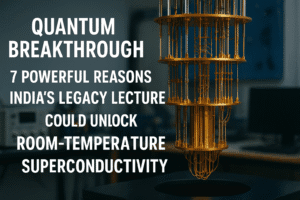Quantum Breakthrough: 7 Powerful Reasons India’s Legacy Lecture Could Unlock Room-Temperature Superconductivity
The 2025 Dr. K. S. Krishnan Memorial Lecture at CSIR-NPL transcended a mere tribute, strategically linking India’s scientific heritage to its quantum future. Honoring its pioneering founder, the event coincided with the International Year of Quantum Science, underscoring NPL’s critical role in quantum metrology for national progress. Distinguished physicist Prof. Ganapathy Baskaran delivered a compelling lecture connecting Krishnan’s historic fascination with graphite to the audacious quest for room-temperature superconductivity.
He proposed that novel carbon structures, understood through advanced theories like RVB, might hold the key to this revolutionary breakthrough – promising transformative energy, medical, and computing applications. Complementing this, a dedicated workshop engaged young researchers and school interns in quantum materials and metrology, with 13 receiving awards, actively nurturing the next generation. This event exemplified how honoring foundational giants like Krishnan isn’t about the past, but about inspiring bold, practical science that bridges legacy with tomorrow’s technological frontiers, positioning India firmly within the global quantum revolution.

Quantum Breakthrough: 7 Powerful Reasons India’s Legacy Lecture Could Unlock Room-Temperature Superconductivity
The recent Dr. K. S. Krishnan Memorial Lecture at CSIR-National Physical Laboratory (NPL) in New Delhi wasn’t just another scientific seminar. It was a powerful confluence of honoring a foundational giant, grappling with one of physics’ most tantalizing challenges, and strategically positioning India within a global technological revolution. Here’s why this event mattered beyond the press release.
Honoring the Architect, Inspiring the Future
Dr. K. S. Krishnan wasn’t merely NPL’s first Director; he was a titan of Indian science. His pioneering work spanned magnetism, Raman scattering, and material properties, laying crucial groundwork for modern physics in India. The annual memorial lecture, running since 1965, is more than a tribute; it’s a deliberate act of lineage, reminding current and future scientists of the high standards and bold vision they inherit. As Dr. Nita Dilawar (Director’s representative, CSIR-NPL) aptly highlighted, Krishnan’s legacy is intrinsically linked to NPL’s core mission: advancing metrology – the science of measurement – as the bedrock of industrial progress, fair global trade, and societal well-being.
Quantum Leap: Timing and Theme
The 2025 lecture gained profound significance by aligning with the International Year of Quantum Science and Technology. Dr. Dilawar underscored the critical nexus between quantum science and the next frontier of metrology. Imagine clocks so precise they redefine the second, or sensors detecting the unimaginably faint – this is the promise of quantum metrology. CSIR-NPL, as India’s custodian of measurement standards, positioned itself at the heart of this transformation, signaling national ambitions in this strategic domain.
Graphite: From Krishnan’s Passion to Physics’ Holy Grail?
Enter Prof. Ganapathy Baskaran, a theoretical physicist of international repute. His lecture title, “Prediction of Room Temperature Superconductivity in Graphite, K. S. Krishnan’s Favourite Mineral”, was masterfully chosen. It wove together Krishnan’s documented fascination with graphite’s unique properties and one of contemporary physics’ most sought-after goals: superconductivity that works without extreme cooling.
Prof. Baskaran didn’t just present a speculative idea. He anchored his exploration in tributes to Krishnan’s own diverse contributions (magnetism, light scattering, alloy properties) and then delved into the deep physics of carbon-based materials like graphite and graphene. The core of his talk contrasted the established Bardeen-Cooper-Schrieffer (BCS) theory of superconductivity with P.W. Anderson’s Resonating Valence Bond (RVB) theory. His compelling argument: the complex electronic behavior in doped graphene and graphite layers might find its best explanation, and path to room-temperature operation, through the RVB framework.
Why Room-Temperature Superconductivity Matters (Beyond the Hype)
Achieving superconductivity without liquid nitrogen or helium cooling isn’t just a lab curiosity. It would be revolutionary:
- Energy: Near-zero-loss power transmission grids, slashing energy waste.
- Transport: Frictionless maglev trains becoming vastly more practical.
- Medicine: Drastically more affordable and powerful MRI machines.
- Computing: Enabling entirely new paradigms in quantum and ultra-efficient electronics.
Prof. Baskaran’s focus on carbon – abundant and relatively easy to work with – adds a layer of tantalizing practicality to this quest, directly connecting Krishnan’s early interests to potentially world-changing future technology.
Nurturing the Next Generation: The Quantum Workshop
The memorial lecture wasn’t an isolated event. It was preceded by a “Workshop on Quantum Metrology, Materials and Technologies” on June 10th, 2025, chaired by Prof. T. Ramasami (Former Secy, DST). Crucially, this workshop wasn’t just for established scientists. Research scholars and even school internship students from CSIR-NPL actively participated, presenting their work. Honoring 13 of these young researchers with Best Presentation Awards during the main lecture event sent a powerful message: India’s quantum future depends on igniting passion and recognizing talent early.
The Enduring Value: More Than Just a Lecture
The Dr. K. S. Krishnan Memorial Lecture 2025 exemplified how scientific institutions can:
- Honor Legacy Meaningfully: By connecting past achievements directly to cutting-edge research questions.
- Drive Strategic Focus: Using commemorative events to spotlight national priorities like quantum technology and advanced metrology.
- Foster Intergenerational Dialogue: Bridging foundational figures like Krishnan, eminent scientists like Baskaran, and the next generation of researchers.
- Pursue Bold Science: Dedicating a premier platform to exploring ambitious, potentially transformative ideas like room-temperature superconductivity in familiar materials.
This event wasn’t just about remembering a great scientist; it was a dynamic demonstration of how his legacy actively fuels India’s journey towards scientific leadership in the quantum age. It reminds us that the materials Krishnan studied with fascination decades ago might still hold the keys to unlocking technologies that reshape our world.
You must be logged in to post a comment.